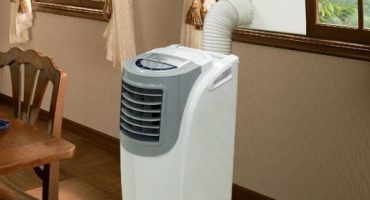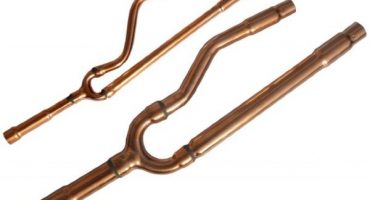Many home and office premises have cooling systems and air conditioning. During operation, harmful microorganisms, bacteria and fungi accumulate inside all devices, and the filters wear out. To ensure that the use of the device is pleasant and long-term, there is no breakdown or illness of users, it is necessary to ensure that the air conditioner is flushed and disinfected in a timely manner. To perform the procedure correctly, it is important to become familiar with the process of cleaning various parts of the system inside the external and internal units.
When you need to think about cleaning the appliance
The air conditioner may not immediately notify about its internal problems. If cleaning does not go as planned, users may notice pronounced signs that the appliance is dirty. Home air conditioning usually requires cleaning much less often than office, because it is used less often and intensively. Among the most obvious symptoms of emerging problems are:
- the appearance of liquid flowing from the unit located in the room;
- steady unpleasant smell from the air conditioner;
- the appearance of interruptions, noise in the system;
- a significant difference between a given temperature regime and its production.
The problems described in the list may be associated with the appearance of harmful bacteria, microorganisms inside one of the blocks or clogged filters. If at least one symptom from the list appears, the user should immediately clean the device. If even despite the appearance of symptoms of the “illness” of the device, the necessary actions are not taken, the probability that the system will fail will multiply increase, and any elements will break down.
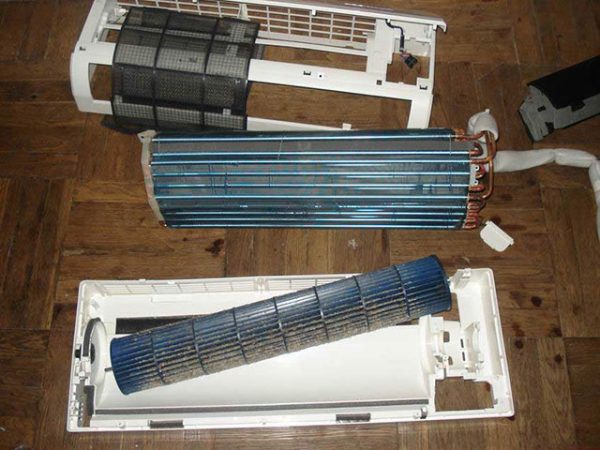
Indoor unit breakdown for parts
What happens if you do not clean the air conditioner:
- The pollution that the air conditioner has collected inside itself will spread throughout the room and circulate intensively. The risk of viral and bacterial infections will increase for all users located in the room that serves the air conditioner.
- There may be problems with the proper operation of the device.
- The system performance will decrease.
You can conduct timely maintenance of the air conditioner with your own hands or you can contact specialized clearing services for help.
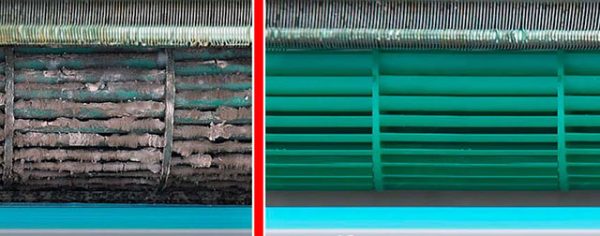
Air conditioning filter element before and after cleaning
How to clean the air conditioner with your own hands
Rinsing the parts of the air cooling system and disinfecting in the home appliance is quite simple. The first assistant for this is the instruction that comes with the device. It details the entire cleaning process. But if the manual is lost or written in a foreign language, you can follow the universal scheme, which consists of 3 stages:
- Clean or replace filters inside the units.
- They clean the internal components of the unit located indoors.
- Serve the street part.
Before starting preventive work, starting to clean any of the blocks, you need to make sure that the device is unplugged.
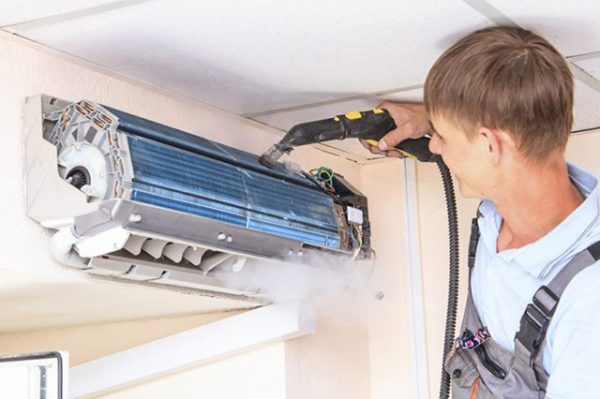
Cleaning the air conditioner at home with professional equipment
Cleaning the indoor unit
The indoor unit of the air conditioner is more exposed to pollution, bacteria and fungi than the external. Due to the fact that this particular housing is responsible for filtering and the quality of the air that enters the interior. The best quality of the internal system can be achieved if it is fully serviced at least once a month.
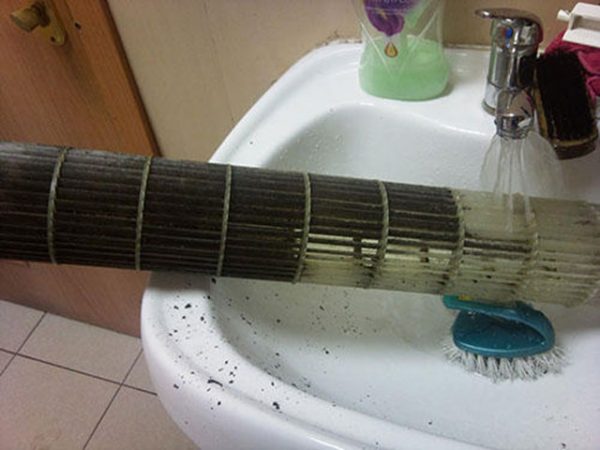
Mold removal from the inside
The disinfection of the air conditioner and its cleaning for the indoor unit should be carried out according to the following scheme:
- Rinse the mesh to clean the air.
- Clean fan blades.
- Clean the radiator and the evaporation area.
- Flush the system responsible for draining moisture.
Disassemble the inside of the air conditioner and wash its parts in stages, eliminating mold in the air conditioner, dust, blockages and other contaminants.
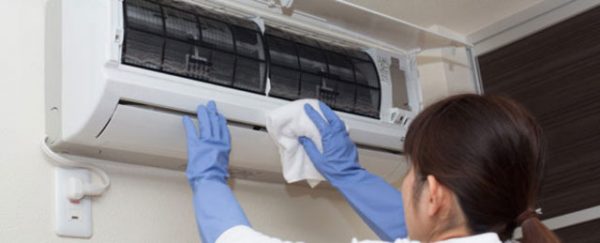
Cleaning the indoor unit
Flushing the ventilation system and filter elements
A filter mesh is placed inside each device, which can be made in a different form, depending on the brand of the manufacturer. The appearance of the mesh does not interfere with the standard procedure for washing it. To execute it, you must:
- Turn off the system.
- Open the top panel of the device by removing several screws.
- Extract item.
- Soak the net in soapy water.
- Rinse clean part under running water.
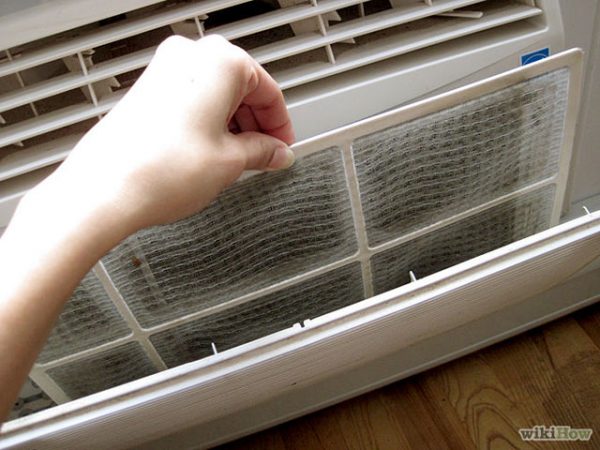
The filter mesh of the indoor unit
After the grid, you need to take care of the fan. In some models, the blades can be removable, in others they will have to be cleaned in the device itself. To clean the removable element, it will be enough to pull out the blades and rinse them in a soap solution. Built-in options will have to be cleaned with a small brush directly in the device itself.
In the event of an unpleasant odor, in addition to the usual washing, it will be necessary to disinfect with a special solution. It will eliminate the accumulation of fungi, will have an antibacterial effect.
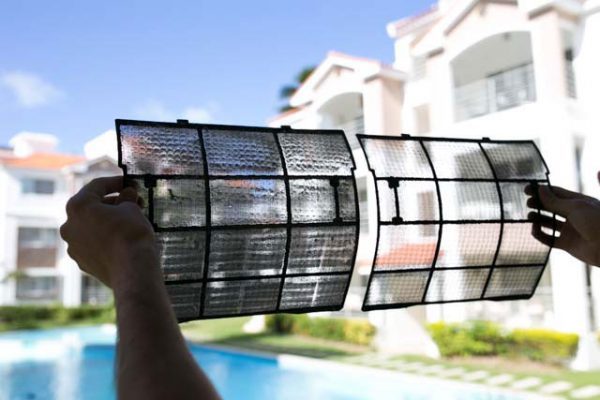
Filter mesh before and after cleaning
Cleaning the radiator and evaporation area
Cleaning the evaporator and radiator is a very complicated and expensive procedure that can only be performed by an experienced service technician. In order not to have to spend money, it is better to systematically process these elements of the device at home yourself.
To clean these items, follow these instructions:
- Remove housing cover.
- Remove mesh filtering.
- Dry remove dirt with a vacuum cleaner or brush. All actions must be directed strictly up and down so as not to damage the parts.
- Remaining debris can be removed with a steam cleaner.
- After all actions, it is necessary to set the air recirculation mode with the lowest temperature.
- Gently spray the antiseptic without getting on the radiator.
Experts recommend cleaning the evaporator and radiator once a month or more, combining it with cleaning screens for air filtration.
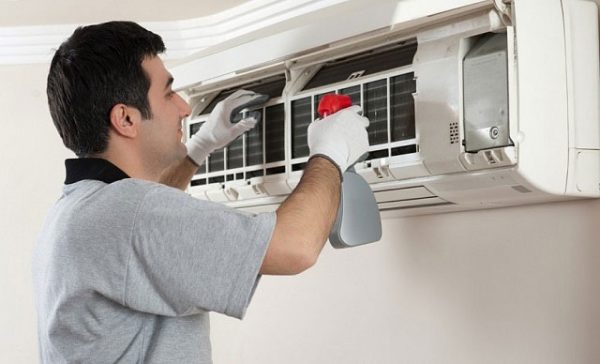
Spraying an antiseptic on the indoor unit
Fluid drain cleaning
Liquid is removed from the air conditioner by means of a tube that discharges water and a container for collecting liquid. If the system is clogged or malfunctioning, bacteria and harmful microorganisms will actively multiply inside it, mold will begin to spread, which will then go to other parts of the device. The main sign that the drainage area is clogged is the flow of water from the indoor unit.
To clean the drain pan for the drain pipe fluid:
- Separate drip tray and pipe.
- Remove the fluid-collecting element and rinse it under running water, having previously soaked it in a solution with any gentle household chemicals.
- Clean the drain pipe with a vacuum cleaner or compressor by blowing it.
- Flush the tube with soapy water.
- If mold appears on one of the elements, the fungus has spread, it is necessary to use means that eliminate them.
- Disinfect the collecting part of the drain system.
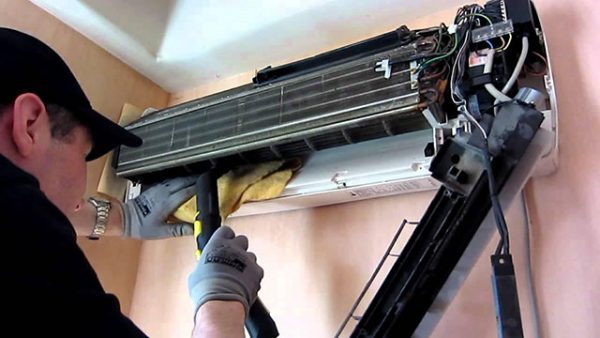
Cleaning the air conditioner with a steam cleaner
Work with the external part of the system
Cleaning the outside of the device is much less necessary. It will be enough to clean the unit once every two years. Such contaminants cannot cause disease, but debris that enters from the external environment can lead to strong heating of the compressor or radiator and their further breakdown.
It is possible to clean the outer area with your own hand only if it is set low or there is special insurance. Usually it is well protected and access to it can be problematic, despite the fact that it is located next to the window. In cases where the air conditioner is fixed at a considerable height or access to it may be associated with a risk to life, you should contact specialists for professional help with cleaning and disinfection.
If there is a possibility of self-access, the following steps should be followed to cleanse:
- Switch off the device.
- Remove all debris from the instrument housing.
- Unscrew the casing protecting the external unit and remove large debris from the inside.
- Wash off any dirt from the fan blades.
- Using water under pressure or a steam cleaner, remove dirt on the radiator, taking care that the electrical part does not get in contact with the liquid.
You can flush with special tools that are sold in hardware stores or with simple household soap.
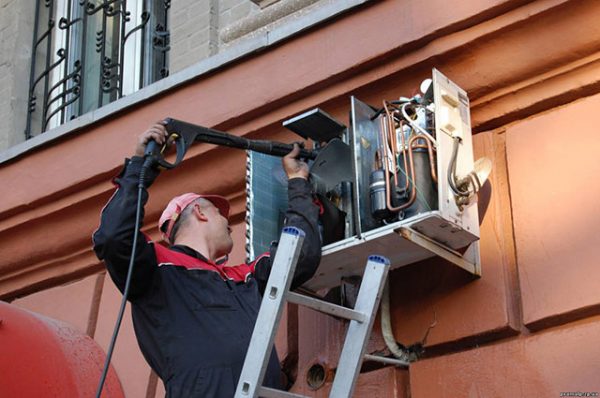
Cleaning the outdoor unit 8
Air conditioning, like any other appliance associated with cleaning, requires systematic maintenance. It is better if the user cleans and disinfects them in a timely manner, without waiting for the system to make strange noises or stink. How often the air conditioner will be cleaned directly affects its life and the incidence of diseases in those who are in the room that the system serves.
The internal unit of the device can be easily cleaned independently, but the external one may require contacting a specialist. On the Internet and newspapers you can find a large number of ads from cleaning companies, so you should not risk your life and health in order to achieve cleanliness.


